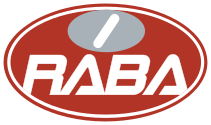Rába (vehicle manufacturer)
| Rába Járműipari Holding Nyrt. Raba Automotive Holding Plc.
|
|
|---|---|
| legal form | Corporation |
| founding | December 28, 1896 |
| Seat | Győr , Hungary |
| management | István Pintér, CEO |
| Number of employees | 1,541 |
| sales | 43.842 billion HUF 135.0 million EUR - |
| Branch | Commercial vehicle manufacturer |
| Website | www.raba.hu |
| As of December 31, 2017 | |
Rába ( Magyar Vagon- és Gépgyár ) is a Hungarian mechanical engineering company that was founded in 1896 a. a. was founded for the production of freight wagons . Rába has been a commercial vehicle manufacturer since 1904.
Company history
After the Second World War , the factory suffered greatly from its reparation obligations, and a year later it was nationalized . Until 1961, commercial vehicle construction was of almost no importance for the factory, wagons were repaired and built. From 1961 to 1969 the company had the suffix: “ Wilhelm Pieck Vagons Gépgyár” and began again with the construction of commercial vehicles.
From 1970 the current name Magyar Vagons Gépgyár was linked to the Rába brand . In 1994 a joint venture with Detroit Diesel was concluded. The company was split up in 1997, with the axles, engine and vehicle manufacturing departments being separated. The Hungarian state was able to keep the majority stake. In 2006, the Estonian investment group Trigon took a stake in the company: Magyar Vagon-és Gépgyár (Rába).
Commercial vehicle construction
Rába began manufacturing commercial vehicles (trucks) in 1904, with passenger cars being manufactured under the same brand until 1925. With a license to build new 5-ton trucks began in 1912. In 1920 Rába acquired a manufacturing license for trucks from Krupp , which was only used from 1927. In 1928 Rába acquired a new license from Austro-Fiat to be able to build trucks. A self-designed 3-ton truck was also produced from 1928. The first engines were manufactured under license from MAN from 1939 to 1945 .
In 1961 a 10.5 t heavy-duty tipper was built, which was later further developed by the Roter Stern company into the Dutra type . From 1963 to 1970 the factory was a supplier of axles and transmissions for other commercial vehicle manufacturers.
With a newly acquired license from MAN (1968), which could Saviem - cab be (MAN Type F 8 from 1967) adopted the Hungarian state of the commercial vehicle industry made capital available. From 1969 Rába buses and from 1970 complete MAN truck types were built under the name Rába. In 1969 this new truck type was shown at the Budapest trade fair with a MAN cab. The DAF 2800 type cab was also used, but only with MAN licensed engines. This was due to the fact that Rába was a parts supplier for DAF , in return DAF supplied cabs.
When the engine output for the GVW of 40 t and more was too weak in the early 1980s, Rába was able to acquire a production license for a 420 HP six-cylinder in-line engine from the Austrian company AVL List, including charge air cooling . Here the Rába truck with the DAF cab and the 420 hp, 12 l diesel engine became real international competition. A well-selling truck was the 6 × 4 tractor unit for 42 t, as well as the new tipper series type K 41. Two and three-axle trucks with DAF and MAN components and all-wheel drive that had between 100 and 420 hp were increasingly built. Since the year 2000 production declined a bit, Rába has concentrated more on vehicle parts, especially axles. Commercial vehicles currently in production are H series military trucks, the S91 bus model and chassis for fire engines from the Hungarian manufacturer BM Heros. 49 fire service chassis were built in 2017.
literature
- Oldtimer Commercial Vehicle Lexicon, page 285. Motorbuch-Verlag, Stuttgart 2008, ISBN 978-3-613-02944-6 .
- Lastwagen der Welt, page 203. Motorbuch-Verlag, Stuttgart 2000, ISBN 3-613-02257-5 .
- Das Lastwagen Lexikon, page 137.Schrader-Verlag, 1998, ISBN 3-613-01837-3 .
- Harald H. Linz, Halwart Schrader : The great automobile encyclopedia. BLV, Munich 1986, ISBN 3-405-12974-5 .
Web links
Individual evidence
- ↑ a b c Rába Annual Report 2017 , at www.raba.hu , accessed on October 6, 2018
- ↑ Rába Vehicle , at www.raba.hu , accessed on September 15, 2015
- ↑ BM Heros-Rába has started the manufacture of fire fighting vehicles , at www.raba.hu , accessed on September 15, 2015






